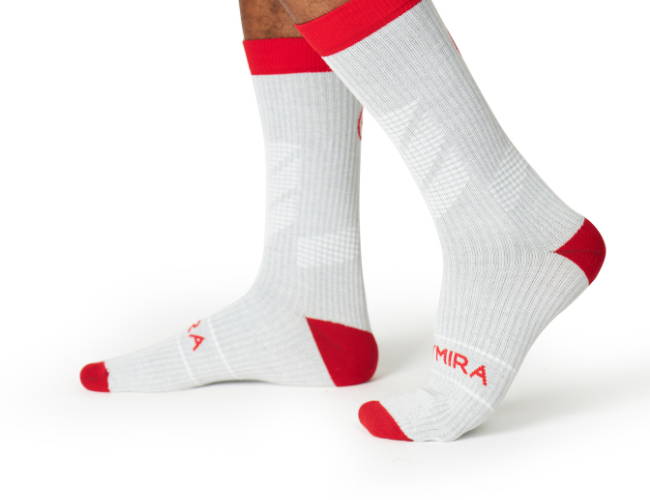KYMIRA® IR Crew Socks Black&Red
According to research, around 1.5 million people in the UK suffer from gout, a chronic and intensely painful joint disease. Historically gout was known as a rich man's disease, but thanks to declining diet quality it is increasing in frequency and is affecting younger people.
A nationwide population study concluded that although gout is on the increase, management of the condition isn't improving and education around lifestyle interventions needs to be more widespread [1].
In this article we're going to look at what causes gout and how you can prevent the issue. We'll also give evidence-based ideas around how to manage the condition if you are a sufferer.
Time to read: 3 minutes
Key Points:
- Tools that are natural, easy & quick to use to provide pain relief
- Stretching, Muscle Rolling, Exercise, Sleep, KYMIRA®
- Personal experience of chronic pain
- Fully scientifically supported & referenced
There are multiple lifestyle interventions that you can employ to reduce your chances of experiencing gout.
What is gout?
Gout is classed as an inflammatory arthritis – the only ‘curable' one too. Arthritis Action describe gout as [2]…
…the accumulation of uric acid in blood and tissues (uric acid is normally excreted from the body via the kidneys), which leads to the formation of uric acid crystals. If these crystals get into a joint, they may trigger inflammation, causing swelling, extreme pain and tenderness…
Typically, gout is treated with non-steroidal anti-inflammatory medications to reduce pain and swelling. In severe and chronic cases, patients will take a medication to reduce uric acid [3]. It's common for gout to run in families, and it is more common in older men. Other risk factors include…
- Being overweight
- Drinking alcohol
- Being post-menopausal
- Taking medicines such as diuretics (water tablets), or medicines for high blood pressure (such as ACE inhibitors)
- Having high cholesterol, high blood pressure, kidney problems, osteoarthritis or diabetes
- Having had surgery or an injury
The good news is that there are multiple lifestyle interventions that you can employ to reduce your chances of experiencing gout, or making any attacks you do suffer from significantly less painful.
Preventing and managing gout
The most important and effective way of preventing gout is by improving your diet [4]. There is a significant body of evidence that links a high fat, high sugar diet to incidence of gout. We also know that being overweight significantly increases the chances of developing the condition, so by removing the high fat and high sugar foods from your diet you also increase the chances of losing weight.
We also know that being dehydrated is a risk factor for gout – you should be aiming to drink around 2 litres of water per day. As well as reduce the chances of gout, it also helps to improve general tissue health. Your skin, muscles, bones, connective tissues, and internal organs benefit from being fully hydrated.
A high protein diet may not be best for gout sufferers, so reducing your intake of red meat, fish and offal will have beneficial effects on your gout risk.
It's not to say you can't eat those foods but keep them to relatively low levels in your diet. Instead, focus on a vegetable-heavy, low fat Mediterranean diet [5]. The bulk of your meals will be low fat carbs, fresh vegetables and a little meat or fish.
Exercise and gout management
There remains a strong case for regular exercise for those who suffer from the condition. In this conclusion taken from a 2020 study [6], physically active gout patients were found to have lower CRP levels, less flares per year, and decreased pain perception compared to those that are not physically active.
There's some debate over the intensity of the exercise that gout patients should undertake, with some studies suggesting that very high intensity exercise can actually cause flare ups. The best suggestion seems to be that frequent exercise is better than high intensity, so aiming for 4-6 days per week of 30-60 minutes will be the most effective for protecting against gout.
How KYMIRA® Infrared technology can help
The infrared fabric used in KYMIRA® garments can help to reduce inflammation, which is one of the aims of the medication for low-level gout flare ups. By wearing KYMIRA® garments you can manage some of the discomfort of the condition without the need for immediately reaching for the pills.
The research on infrared and pain shows that an intervention using infrared technology can help to reduce pain significantly [7]. A combination of wearing KYMIRA® garments and adopting the lifestyle intervention advice in this article should see you reduce your gout suffering in terms of the frequency and severity of attacks.
Managing gout – final thoughts
The evidence suggests that way to reduce gout flare ups is to practice health lifestyle behaviours regularly.
Improving your diet, stopping smoking, reducing alcohol intake and exercising regularly should see you suffer a lot less from the ill effects of gout, and at the same time improve your general health considerably.
To find out more about the suitable KYMIRA Medical products for you, click here .
Expand For References[1] https://ard.bmj.com/content/74/4/661
[2] https://www.arthritisaction.org.uk/blog/gout-cases-rise-in-uk/
[3] https://www.nhs.uk/conditions/gout/
[4] https://www.ncbi.nlm.nih.gov/pmc/articles/PMC6125106/
[5] https://www.ncbi.nlm.nih.gov/pmc/articles/PMC6950134/
[6] https://ard.bmj.com/content/79/Suppl_1/1766.1
[7] https://www.practicalpainmanagement.com/unique-use-near-infrared-light-source-treat-pain
